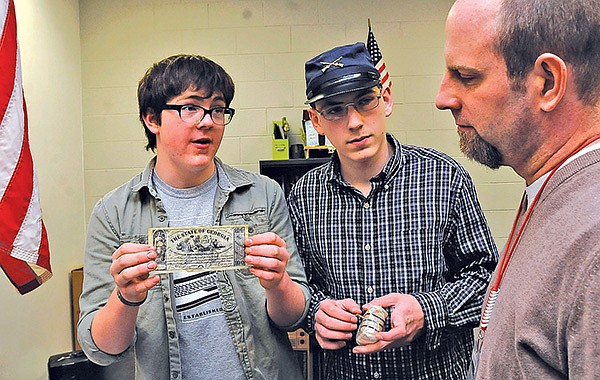Rogers Students Explore Underlying Themes Of Civil War
STAFF PHOTO FLIP PUTTHOFF Noah Smith, left, shows Wednesday some replica Civil War era currency while classmate Hunter Satterfield, center, sports a Union soldier’s hat. Danny Burdess, right, history teacher, listens to the presentation about the students’ Civil War project.
Thursday, February 13, 2014
ROGERS — Students clustered around display boards and dioramas at New Technology High School on Wednesday.
The assignment for the sophomores was to study the causes and effects of the Civil War, its influence on Benton County and period authors. For freshmen in the American studies class, a combined class of history and English, the final presentation was like a unit final, said Casey Bazyk, an English teacher who co-teaches the class with Danny Burdess, history teacher.
Students had to make a display and a multimedia presentation. Teachers toured the displays and quizzed students on what they learned.
“The war pretty much started because of authors,” Juan Belloso said.
The book “Uncle Tom’s Cabin” persuaded people of the injustices of slavery and caused people to be willing to fight, he said.
“We feel like most people look at the war from the perspective of the side that won: the Union,” Noah Smith said.
Slavery wasn’t the tipping point of the war although the practice ended in the United States as a result of the war, other students said.
The laws about slavery came later, Dillon Ketron said.
The conditions of slavery never entirely went away, students said, citing child labor laws and sweatshops.
WEB WATCH
ANNIVERSARY
The 150th anniversary of the Civil War continues through 2015. Find commemorative events in Arkansas by visiting the Arkansas Civil War Sesquicentennial Commission at www.arkansascivilwa….
The start of the Civil War was complex, they said.
“It’s not just going to be about slaves. It’s going to be about money and politics and economics,” Vicente Guerrero said. “Most people would like to dumb it down to just slavery.”
He brought two journals for his team’s display. One was the Civil War-era writings of a Confederate lieutenant. The other he wrote himself. Each entry in Vicente’s journal starts with the number of troops and a location he picked by reviewing records, then calculating walking distance using Google maps.
Teammate Ben Redmond compared poverty in the South with northern factories while Jacob Byrd looked at the rise of the Ku Klux Klan after war. Prejudices still exist but have changed as the racial makeup of the United States has shifted, the boys said.
Being able to defend their answers is part of demonstrating their learning, Burdess said. The school uses projects to teach students. Most projects are digital, either through use of a slideshow presentation or video or even a podcast. The Civil War presentations gave students with a more artistic bent an opportunity to shine, he said.
Students were given the goal, some instruction and asked to research the topic. They also visited the Rogers Historical Museum to get a tutorial on creating museum displays and heard a talk on local Civil War history.
“If they’re telling me stuff that I don’t tell them in class, their score exponentially increases,” Burdess said.
Student presentations were impressive because of the variety of background information, said Robert Rousey, curator of education at the museum.
Staff members talked to the students about using sources such as the Library of Congress and Encyclopedia of Arkansas as well as museum documents for their projects. Some students found resources he hadn’t seen before, Rousey said. One group used Andy Thomas’ artwork commissioned by the Pea Ridge National Military Park Foundation, but also requested the artist’s permission. That extra step is rare, he said.
Students said they learned from their research.
Weaponry played a big part in the Civil War, Noah Grant said. His team mocked up a wooden piece the height of a Springfield rifle and another the size and shape of a more modern weapon.
A .58-caliber shot from the Springfield rifle was the size of a quarter and could have dented a tank, he said.
“I learned there were more deaths than any other war,” Mike Ohl said.
His team talked about the conflict of brother against brother. A war today would be shorter, but just as deadly because of the development of bombs, he said.
“The war caused more friction between people than peace,” he said.
